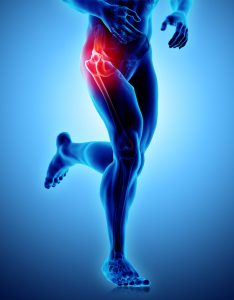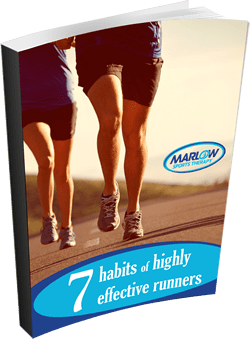Doing these 6 hips stretches can relieve back, thigh and knee pain!
Inflexibility of the hips is one of the biggest causes of my clients chronic pain. Time and time again I see desk or driving work, post-pregnancy or lots of running and cycling creating lots of tension around your hip muscles. These muscles tend to get neglected but in fact tightness in these muscles can be a huge contributor to chronic lower back, thigh and knee pain.

The stretches will be most effective after exercise, holding each one for at least 50 seconds. Repeat on both legs! I’d recommend doing them 3/4 times per day if you have an issue. First and last thing at night and after exercise or after being sat down for long periods. Apologies for the poor sound quality of the video… it was filmed at a local running event we work at.
Rectus Femoris (the 4th Quad Muscle)
If you could only do one stretch, not knowing what your problem is, I would choose this one. Only because it tends to be very tight in 80% of people I see and can be a direct cause of anterior knee pain and THE indirect cause of lower back pain. The key to this stretch is pulling in your core and not allowing the lower back to arch or front of hips to drop when fully bending the knee – see end of video. The stretch needs to be felt down the front of hips. If needed, bend the standing leg to feel a stronger stretch. AS with any stretch or exercise – if it’s recreating your pain DON’T DO IT or try in a different position. Get advice from a professional if unsure.
Tensor fascia latae (TFL)
This muscle is the ‘jack of all trades’ at the front of the hip. It assists in flexion, internal rotation and abduction of the hip. To stretch it effectively you need to move into all 3 planes of movement. It can get very tight in cycling and running and then sitting a lot means it stays tight. Weak hip flexors and quadriceps often make this muscle over-compensate and get chronically tight. It can go into acute spasm if you ‘miss a step’ and jar your leg/torso , creating searing pain down the thigh.
Gluteus Muscles (Group)
There is actually 3 stretches in this video as the different angles will stretch different part of your gluts (backside) and other posterior hip muscles. Time and time again I see tightness in these muscles lead to lower back or knee pain. The hip rotator muscles tend to get very tight simply because we don’t rotate our hips that much as adults. Running and cycling are primarily 1-dimensional hip activities (forward & back movements) so the rotator muscles tend to get tight through lack of use.
However, some hip rotation is VITAL for all movements. A lack of hip rotation potentially means ‘shearing’ forces being transferred to either the lower back or knee, causing chronic pain.
Pulling the foot round in 2nd and 3rd part of stretches below is key to getting the rotation force need to stretch the ‘rotator’ hip muscles.
Hip flexor stretches
A sedentary lifestyle with too much sitting can weaken and tighten this muscle. It can then refer pain into the lower back
Piriformis and other external hip rotators
These are major stabilisers of the hip joint and laterally rotate or turn-out the feet. Tightness can lead to hip and/or buttock pain. Stretch on the floor like this.
Occasionally hip pain can be referred from the Hamstring and Adductor muscles … Tension or repeated strains in these muscles can mean they are tight/hurting because of over-compensation from dynamic instability through the pelvis. Its prevalent in runners and cyclists.
Again, if any of these stretches recreate your symptoms DON’T do them – they are not for you! These are just the stretches which . If the muscles are tight I’d recommend doing the stretches 4 times per day, holding each one for 40-50 seconds. Ideally stretch when the muscles are warm (after exercise).
Its possible your pain is originating from a muscle or is not muscular at all. Its also possible that your muscles are so tight that self-stretching is not resolving the problem in which case you would really benefit from booking a sports therapy or sports massage session to resolve the issue.
Acute pain may mean trying to do these stretches yourself is too painful. There are adaptations that can be made – have a full assessment with a sports therapist. Contact us for more details or advice

 Enter your name and email and request our free ebook: 7 Habits of Highly Effective Runners
Enter your name and email and request our free ebook: 7 Habits of Highly Effective Runners